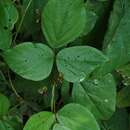Physical Description
provided by USDA PLANTS text
Perennial, Herbs, Vines, twining, climbing, Stems woody below, or from woody crown or caudex, Taproot present, Nodules present, Stems or branches arching, spreading or decumbent, Stems prostrate, trailing, or mat forming, Stems less than 1 m tall, Stems 1-2 m tall, Stems greater than 2 m tall, Stems solid, Stems or young twigs glabrous or sparsely glabrate, Stems or young twigs sparsely to densely hairy, Stem hairs hispid to villous, Leaves alte rnate, Leaves petiolate, Stipules inconspicuous, absent, or caducous, Leaves compound, Leaves pinnately 3-foliolate, Leaves odd pinnate, Leaf or leaflet margins entire, Leaflets opposite, Leaflets 3, Leaves glabrous or nearly so, Leaves hairy on one or both surfaces, Inflorescences racemes, Inflorescence axillary, Inflorescence or flowers lax, declined or pendulous, Bracteoles present, Flowers zygomorphic, Calyx 2-lipped or 2-lobed, Calyx glabrous, Calyx hairy, Petals separate, Corolla papilionaceous, Petals clawed, Petals white, Petals orange or yellow, Petals blue, lavander to purple, or violet, Petals bicolored or with red, purple or yellow streaks or spots, Banner petal suborbicular, broadly rounded, Wing petals narrow, oblanceolate to oblong, Wing petals auriculate, Wing tips obtuse or rounded, Keel tips obtuse or rounded, not beaked, Stamens 9-10, Stamens diadelphous, 9 united, 1 free, Filaments glabrous, Style terete, Fruit a legume, Fruit unilocular, Fruit freely de hiscent, Fruit elongate, straight, Fruit oblong or ellipsoidal, Fruit exserted from calyx, Fruit compressed between seeds, Fruit glabrous or glabrate, Fruit hairy, Fruit 3-10 seeded, Seeds ovoid to rounded in outline, Seed surface smooth, Seeds olive, brown, or black, Seeds with appendage - aril, caruncle, funiculus, or strophiole.
Neonotonia wightii: Brief Summary
provided by wikipedia EN
Neonotonia wightii, the perennial soybean, is a species of flowering plant in the family Fabaceae, native to sub‑Saharan Africa, Yemen, India, and Sri Lanka, and widely introduced as a forage in Brazil, Bolivia, Paraguay, northern Argentina, the Mascarene Islands, Peninsular Malaysia, Java, New Guinea, Queensland and New South Wales in Australia, and Fiji. It is shade tolerant.
- license
- cc-by-sa-3.0
- copyright
- Wikipedia authors and editors

